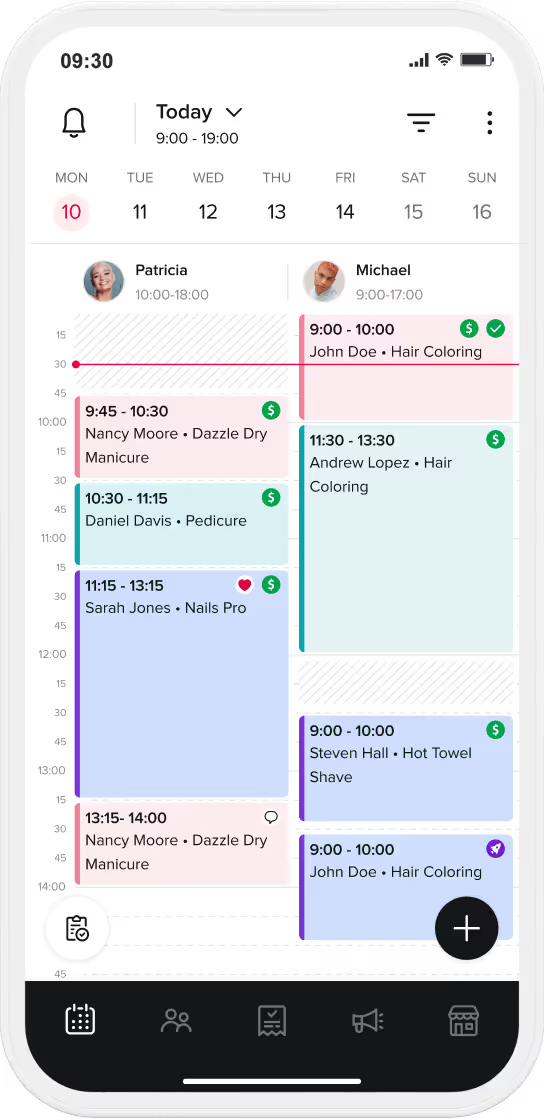

If you’re someone who cares about male grooming, loves serving clients, and has a keen eye for style, then starting a career as a barber might be the perfect choice for you. But how to start a barbershop and make sure to be successful?
Here’s the great news: barbers are thriving right now. The male grooming industry has been steadily growing since 2013 and is expected to be worth $26 billion by 2020.
With that in mind, if you’ve ever considered opening a barbershop, now would be an excellent time to do so.
Not sure where to start? To give you some clarity into what it takes to successfully start a barbershop, here are 8 steps you need to take to get there:
Every good business begins with a plan. Before you start scoping out locations or sharpening your tools, take some time to lay out how you’re going to establish and run your company. In short, if you're wondering how to start a barbershop, the very first step is to create a business plan.
This doesn’t necessarily have to be a big formal document (unless you’re planning to get a loan or bring in some investors). But it helps to have something on paper — even if it’s just for your personal reference. Having a tangible plan will help you get organized and bring clarity into what you need to do.
So, what should your business plan contain? Here are some of the things you need to iron out:
Kick things off with a brief summary of your mission and vision for your barbershop. If you're planning to show your barbershop business plan to someone else, this section should capture their attention and compel them to keep reading.
Let’s say an experienced barber — let’s call him Josh — wants to launch his own shop to cater to his growing client base. His business plan overview could start with something like…
Josh's Barber Co. offers a premium barbershop experience for busy professionals. We strive to go beyond selling run-of-the-mill grooming services, and instead provide rich experiences that clients will genuinely enjoy…
From there, Josh can specify his specific mission and vision for the business and talk about what differentiates his barbershop from the rest.
As an entrepreneur, you need to be fully aware of the state of your industry and market. Who are the other players in the space? Where is the industry going? There are just some of the questions you should answer.
Do research into the barbershop industry both at a national and local level. Look into the average revenue and margins of barbers in your area. It can also help to check out the competition. Scope out the top barbershops in your city to see how they operate.
After doing your research, you should have a clear idea of the following:

The next section of your business plan is all about sales and marketing. This section should cover:
Products and services - What are the specific services that you’ll offer in your shop? Typically, this section would contain offerings like:
If you’re planning to specialize in a specific service or sell products in your barbershop, be sure to mention them in this section.
Pricing - This is where you talk about your pricing strategy. A number of factors will come into play here. Costs and margins are primary considerations, but you should also factor in your positioning (i.e., budget vs premium prices) as well as your location and competitors.
Marketing and advertising - There should be a section on how you intend to promote your barbershop. How are you planning to get the word out? Discuss your overall strategy and include tactics such as:
Your business plan should also talk about how you’ll handle the finances in your barbershop. Whether you’re planning to fund the business yourself or obtain financing from a third party, you’ll need to specify the details.
Try to come up with your projected cash flow, revenue, expenses, and profit. Aim to predict how much you'll earn for at least the first year of your business.
The next section of your barbershop business plan is all about operations. This section should discuss how you plan to operate your business. You need to tackle things like:

Once you have a plan, the next step is to figure out the legal structure for your barbershop. This will affect how you file your taxes, fund your business, and manage your financials, so it is critical that you choose the right structure for your situation.
Barbershops in the US generally have the following options:
A sole proprietorship doesn't distinguish the business from its owner. This means that any income that you earn from your barbershop will go into your personal tax return. The main advantage here is that a sole proprietorship is easy to set up and maintain. There’s no application process, and tax filing is much simpler because everything is reported under your name.
The downside? If you're a sole proprietor, you are personally liable for the business' financial obligations. This means creditors can go after your personal assets if your business defaults on loans or bills.
A sole proprietorship may be right for you, if you’re starting a small barbershop and you’re not planning to hire employees or attract investors.
A C-corp operates as a separate entity from its business owners, so your personal assets are protected from any financial obligations. C-Corporations also make it easier to issue stock and raise money. An S-Corp functions similarly but is taxed as a sole proprietor, meaning the business income will be reported on the owner’s personal tax return.
A big disadvantage for both these entities is that they can be expensive to establish and maintain. There's a lot of paperwork involved, and taxes may get more complicated.
These business models are ideal for barbershops that are looking to expand to more locations, hire large teams, and get outside investors.
Think of an LLC as a hybrid between a sole proprietorship and a corporation. It functions as a separate entity for the individual, so you're protected from any personal liabilities. In terms of taxes, your LLC income will be reported on your personal tax return.
LLCs have some limitations, though. For starters, it could put you in a higher tax bracket, particularly if your barbershop isn't your only source of income. This could result in higher taxes. Additionally, you can't issue stock to shareholders and certain business loans are only available to corporations.
An LLC may be right for your is you're looking to be the main boss in your barbershop and are planning to hire a handful of employees, but you’re not planning to take on investors or issue stock to shareholders.

Next, let’s talk about the funding of your venture. If you want to start a barbershop, you will need to come up with enough money to cover the start-up expenses. You also want to ensure that you have enough cash flow to cover the first 6 months or even the first year of activity.
As a rule, always try to be "pessimistic" when you work on your financial projections. Also, plan a "safety net" to be able to deal with any unexpected expenses.
You have a number of options for financing your barbershop. They include:
TAP INTO YOUR SAVINGS OR OTHER FINANCIAL ASSETS
If you have substantial savings, you could potentially use that money to fund your business. Tapping into your savings prevents you from taking on debt, thus reducing your financial liability.
If you have a retirement account such as a 401(k), you may be able to use those funds to finance your business. Doing so does require a number of legal steps, so consult with business and tax professional before doing this.
You could also apply for a business loan through your bank or credit union. Just bear in mind that you may need a high credit score and/or collateral in order to get approved.
If you’re unable to obtain a loan from your bank or credit union, see if you can secure an SBA loan. Backed by the U.S., Small Business Administration, SBA loans let you borrow money for various business-related expenses, including working capital, purchasing equipment and supplies, buying real estate, and more. SBA loans don't require high down payments and they offer reasonable interest rates. Do note, though, that the process for getting approved can take longer than conventional loans.
Financial institutions, lenders, and even payment processors like PayPal can offer lines of credit to businesses in need of funds. Similar to obtaining a loan, securing a line of credit requires you to go through an application process, in which the lender gauges your creditworthiness. If all looks good, you can get approved for a credit line just a few days.
Consider approaching your relatives and friends for an investment or loan. This is a very common practice, particularly for entrepreneurs who are unable to obtain a loan or credit line.
Just exercise some caution when coming up with an agreement with your friends and family. Have a formal contract in place detailing the terms of your agreement, as well as a timeline for when and how you will pay them back.
No matter what type of financing method you choose, it’s important to have proper documentation. Prepare your credit report, bank statements, and any proof of assets that you have. Doing so will make the process for applying for a loan or line of credit much easier. And even if you’re tapping into your own funds, having your docs in order will allow you to better plan your business financials.
Barbershops need to pass several regulatory requirements depending on their jurisdiction. The criteria will vary depending on your state, county, and city, so check with your local authorities to determine the licenses, permits, and certifications that you need to obtain.
At the most basic level, though, you need to be a licensed barber to be able to start a barbershop. Obtaining your barber’s license requires either completing an apprenticeship or going through an approved education program (in some cases, you may need to do both).
The specific requirements will depend on where you plan to become a barber. Julio Martinez (@j.marrtt) who works at The Rich Barber Hair Studio in Sacramento, says that in California, apprentice barbers need to complete a minimum of 3,200 hours of on-the-job training over a 2-year period.
If you choose to go to barber school, you’ll need to apply at an approved institution and complete the program (this typically takes six months.)
In addition to having your license, you need to ensure that your facility meets certain criteria. The most common ones for barbershops include:
Again, these things vary from one state or city to the next, so check your local and state offices to determine which regulations to comply with.

When you start a barbershop, the choice of location can make or break your business, so it’s important to find the right spot. Thanks to technology, it’s a lot easier these days to find available commercial spaces for lease. Websites such as Craigslist and LoopNet are great places to start your search. You could also contact a real estate broker or agent in your area to show you available spaces.
There are a number of factors to consider when looking for the right barbershop location, including:
You need to be keenly aware of who your target clients are. How old are they? Where do they live and work? How much do they earn? The answers to these questions will point you in the right direction.
For instance, if you’re targeting young male professionals with lots of disposable income, then it makes sense to set your sights on high-end areas. Or, if you’re looking to cater to a hip and trendy clientele, then setting up shop in an up-and-coming neighborhood would be a smart move.
When budgeting for your lease payments, you want to allocate about 3% to 10% of gross monthly sales. This means that if you're projecting your sales to be $25,000 per month, then your rent budget shouldn’t exceed $2,500.
Get a feel for how much foot traffic a location is getting. Depending on the location, you may be able to get some estimates through your broker or the property management company.
The quality of traffic is also important. When scouting rental spaces, pay attention to the people in the areas you’re considering. You don't want to start a barbershop in an area where you won't find enough potential clients. Do they fit the profile of your target customers? If not, you may need to check out other places.
Pay attention to the shops in the location that you’re viewing. Will you have anchor tenants in the same location? Are there any establishments that naturally draw in more people — e.g., train stations, shopping centers etc.?
Consider the case of The Well Kept Barbershop in Astoria, New York. According to Luis Concha (@luthebarber_), one of the shop’s owners, when he and his partner were scouting for places in which to set up shop, they chose Astoria because it was home to establishments that attracted lots of people.
“We are not originally from Astoria, but we knew the area evolved over the last 10 years, and we wanted to be part of that evolution,” he says.
“With trendy bars, vintage style restaurants, and the 30 Avenue train station just a few feet away, we are in a prime location for massive foot traffic!”
Another tip? Try not to rush the process. As Luis puts it, “location is important, so don’t rush into just anything. There can be a lot of pressure to get into the first thing you see. It’s so funny because when we first saw our location it was beat up and old. We had seen so many locations in brand new buildings and every time we would bid on them we would get turned down.”
“In the end, it was the old beat up place that we turned into a vintage yet modern style barbershop!”
The next step is to figure out the tools and technologies you need to run your barbershop. It’s not advisable to do everything manually. Carrying out tasks using a pen and paper can be time-consuming and can lead to human errors. You’re much better off using tech solutions to streamline the various processes in your barbershop.
Consider the following:
Appointment management is essential to consider when you are about to start a barbershop. As a service-based business, you need to be able to keep track of your bookings and manage your calendar.
The best way to do that is through a cloud-based scheduling platform. There are several appointment schedulers for barber in the market, such as Booksy, that offer numerous benefits, such as strong calendar management features so you and your team can keep track of all your bookings and ensure that clients are served on time.
Having an online booking software also opens up more scheduling options for your customers. Most solutions provide a booking portal that allows clients to reserve appointments through your website, as well as on Google, Instagram, and Facebook.
Here’s a great example of a booking page from the Well Kept Barbershop. The page showcases all the available services and time slots and it lets clients book appointments with just a few clicks.
All barbershops need a system that lets them ring up sales and take payments. This is where your point of sale software comes in. A good POS should streamline your checkout process so clients can pay for your services with ease.
When you start a barbershop, staying on top of your books is critical. Arm your business with an accounting system (ideally one that integrates with your POS) that can track your revenue and expenses. Aside from keeping your financial ducks in a row, a good accounting software will give you the data you need to make the right financial decisions for your business.
This is a must if you’re going to hire a team. You need a platform for managing your employees’ schedules, so you can make sure that you always have someone to man your barbershop.
Let’s talk about building your dream team. Especially at the stage when you just start a barbershop, recruiting the right people to work at your shop can be a challenge. You’ll need to find individuals who not only possess the right skills, but are also a good fit for your brand.
The easiest way to find applicants is to set up your online employer profile and post job listings. Start by researching barbershop trade groups and publications and see if they have a “Careers” section on their website.
Here are some examples:
If you want to widen the net, you could also post listings on sites like Monster.com and Indeed. Share a few details about the project and your values. Explain that you are about to start a barbershop and that you're looking at creating the perfect entourage.
Connecting with other barbers can also help. Widening your network opens up opportunities for referrals and help you discover great talent, so ask your barber friends for recommendations.
Regardless of what hiring tactic you decide to implement, make sure that you’re setting your sights on individuals who align with your values.
Chuka Torres (@chukathebarber), the Founder and CEO at The Rich Barber, does just that, and it’s worked out great for his team.
“When you start a barbershop, I think it’s is important to hire people that fit into the established barbershop culture and people who share similar values. Unity and synergy is very important to us at The Rich Barber. Also, I like people who are ambitious and ready to learn and grow. I like when they fit with the culture, share similar values and are ambitious they usually work out,” he says.
And when you do hire your employees, be sure to communicate with them. "It is very important to always have clear communication and expectations,” shares Chuka. He adds that regular check-ins can also be beneficial.
According to him, they have check-ins and meetings with their barbers, and while they aren't mandatory, they've found these check-ins to be "very uplifting, so barbers don't mind and they participate." Their meetings also promote harmony and unity in the shop. That's even more crucial when you start a barbershop and need to create your work culture.
Next up is marketing your barbershop. Start coming up with ways to drive traffic and sales for your business. There are tons of tactics to consider when you are about to start a barbershop (or any other business), but here are the most common ones:
Tap into your existing clients - If you’re a practicing barber, chances are you already have a client base eager to sit on your chair. Use this to your advantage by asking your existing customers to refer you to their network.
Antione Dunn, a barber at The Rich Barber Hair Studio, did just that. “When I first started out, I asked clients to refer my services to the people they know,” he shared. Doing this helped Antione build up his clientele particularly in the early days.
Search marketing - You want to make sure that people searching for a barber can easily find your shop online. A big part of doing that is optimizing your business for search engines like Google.
You can start by creating a local listing on Google My Business. When you set up your profile, include as many details about your barbershop as possible, and upload several photos and videos. Doing so will make your listing look much more attractive.
Implement social media marketing - Having a strong social media presence can do wonders for your barbershop. A survey by Booksy found that the majority of respondents — 85.6% to be exact — said they look at a service provider’s social media accounts before trying them out.
Social media clearly plays a big role in consumer’s purchase decisions, so it’s important that you establish a strong profile, particularly on places like Facebook and Instagram. Be consistent with publishing top quality content on these social networks, and don’t forget to give potential clients the opportunity to book an appointment right from your social media profiles.
Let your work speak for itself - Last but not the least, is letting your work for itself. The best strategy for attracting new customers and keeping your existing clients coming back is to consistently deliver top-notch results.
For Julio, this has been key to his success. He’s an apprentice at The Rich Barber Hair Studio, but he already has a steady stream of clients and a huge following on Instagram (75,000+). According to him, he was able to achieve that by delivering exceptional services time and time again.
"Being consistent with my haircuts has been critical to my success. I've gotten tremendous word of mouth because of it. That's kind of the oldest trick there is [word of mouth], but it's how I got around.”
Youssef Barber (@youssefbarber), CEO of Diamond Cuts, offers similar advice. "I have always been consistent and dedicated to the business. I would be in the shop from open to close, and even after hours. And I would do that daily," he says.
Doing so, according to Youssef, was key to his success. And it is even more when you just start a barbershop and need to build your reputation.
Ready for your grand opening? Starting a barbershop business can be challenging. As you’ve seen in this post, it takes several steps to get up and running. That being said, if you’re highly skilled and passionate about what you do, the venture will be more than worth it.
We hope the tips above bring you clarity and help you take the first few steps to open the doors to your barbershop.
The most crucial first step is creating a detailed Business Plan. This document should outline your vision, services, pricing, and financial projections for at least the first year of activity.
The Limited Liability Company (LLC) is often recommended. It protects your personal assets from business liabilities and simplifies tax filing by reporting income on your personal return.
When budgeting for rent, you should generally allocate between 3% to 10% of your projected gross monthly sales to ensure the location is financially sustainable for your business.
You must be a licensed barber to legally open and operate a barbershop. This typically requires completing an approved education program or a state-mandated apprenticeship.
It is essential for 24/7 online booking, calendar management, and automatically sending appointment reminders, which helps reduce no-shows and streamlines daily operations instantly.

